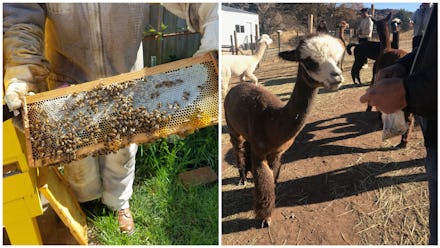Animal tourism can be cruel. Airbnb wants to help you find an ethical alternative.

When beekeeper Kendal Sager handed me a wooden rack crawling with what looked like several dozen honeybees, I felt my stomach do a somersault. I knew the thick beekeeper’s suit would keep me safe, but I still couldn’t entirely shake my intense, nearly lifelong fear of bees (a cosmic dad joke: My name, “Melissa,” means “honeybee” in Greek, and the term for fear of honeybees is “melissophobia”). How did I get into this situation to begin with? I was attending an Airbnb Animal Experience, a new category in the travel platform’s various excursions.
As I watched the bees resume business as usual, and as Sager pointed out the translucent, viscous royal jelly — a source of food for larvae and adult queens — in some of the hive cells, my fear gradually gave way to fascination.
By the end of my hour-and-a-half visit with the bees, which Sager hosted in her Alameda, California backyard, I had interacted with honeybees, but without completely disrupting them, and learned a ton about them in the process. This is a goal Airbnb prioritized when figuring out how to make these animal adventures happen: to foster respectful connections between people and animals.
So far, over 1,000 Animal Experiences, offered in nearly 60 countries, per The New York Times, have emerged on the app at a moment when young people are craving travel experiences that are not only unique, but also ethical and socially aware. Especially in the wake of documentaries like Blackfish and amid growing scrutiny over the damaging environmental and cultural impacts of ecotourism, our generation is done with riding on elephants and swimming with dolphins in a tank that probably feels like jail to them.
Instead, interacting with animals in ways that prioritizes their welfare is seen as both cool and kind. This, in turn, seems to be part of a broader shift toward conscious consumption, falling in step with our embrace of secondhand shopping and spurning of carbon-intensive fast fashion, for instance.
Instead, interacting with animals in ways that prioritize their welfare is seen as both cool and kind.
Clearly, someone at Airbnb identified this shift in the way young people want to travel. In collaboration with the nonprofit World Animal Protection, the company drew up an animal welfare policy that all animal owners, or hosts, are required to follow in order to be featured on Airbnb, according to the Times. As outlined in an Airbnb statement, the policy prohibits petting and other direct contact with wild animals, as well as using them as “selfie props.”
The same goes for animal performances, captive marine animals, big cat interactions, and elephant rides. Donkeys and other domesticated work animals can transport a maximum of one rider, who shouldn’t exceed more than a fifth of the animal’s weight. In addition, proceeds from reservations of more than 100 Animal Experiences — so-called Social Impact Experiences — go toward veterinary care, conservation, and other nonprofit organizations.
A colleague of mine did an "Alpaca Encounter" at a gorgeous, eco-conscious ranch in Colorado, where for $35 a person, she spent time learning about and then interacting with the coolest squad of alpacas ever (though she admits, she doesn't have another squad to compare them to). During the experience, the host explained ethical practices of breeding and shearing, as well as how the little guys interact with each other and with humans.
Animal experiences range from $10 to $500, though the average price hovers at $50, per the Times, and they’re typically hosted by biologists and other experts. Regularly priced at $49 (but provided to me, gratis, by Airbnb so I could try it before writing this), the experience I attended included a crash course on everything from hive hierarchy — explained with the help of Game of Thrones references — to how bees make honey.
There was then a glimpse into a backyard hive and a tasting of the honey produced by Sager’s bees, housed in 30 hives throughout the San Francisco Bay Area. Sager, who left a tech career at Dreamworks Animation before taking up beekeeping, according to The Mercury News, is a member of the California Master Beekeeper Program at UC Davis and has extensive experience educating youth and adults alike about honeybees.
Beekeeping and interacting with animals on a farm are some of the more popular Animal Experiences, but others are more immersive, such as a three-day safari with a Masai guide in Nakuru, Kenya. There are plenty of urban Animal Experiences, too. You can picnic with Pickles the pig at a park in San Francisco, do yoga with rescue cats in Brooklyn, and photograph birds in Toronto.
I initially signed up for the Animal Experience with Sager to help me overcome my fear of bees, and left with deepened admiration for their productivity and exquisitely organized matriarchy, as well as concern for their falling numbers in the US (whose cause still remains unclear). I’m definitely not ready to cuddle up with a honeybee, but maybe that’s the attitude we need to preserve when connecting with wildlife: awe, paired with some distance and respect.